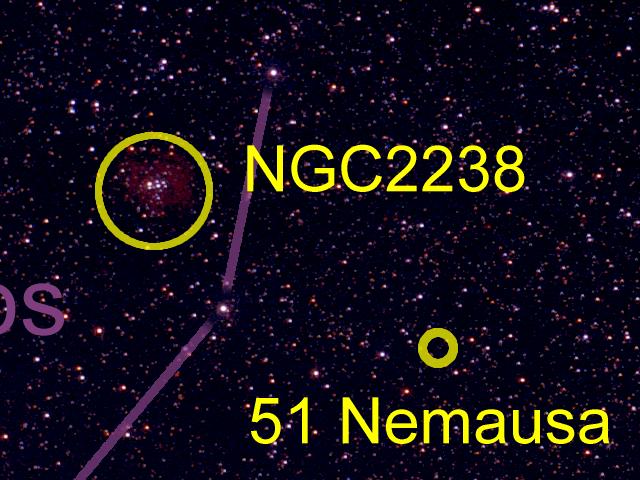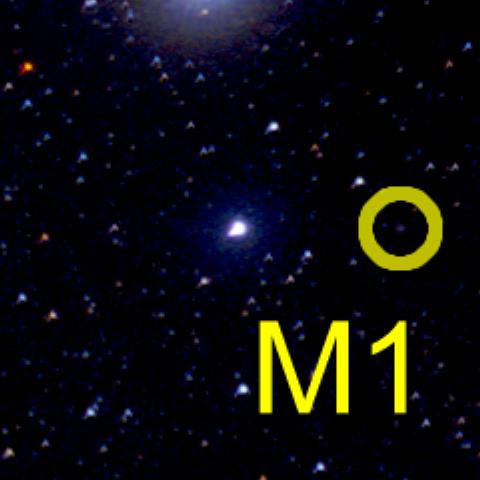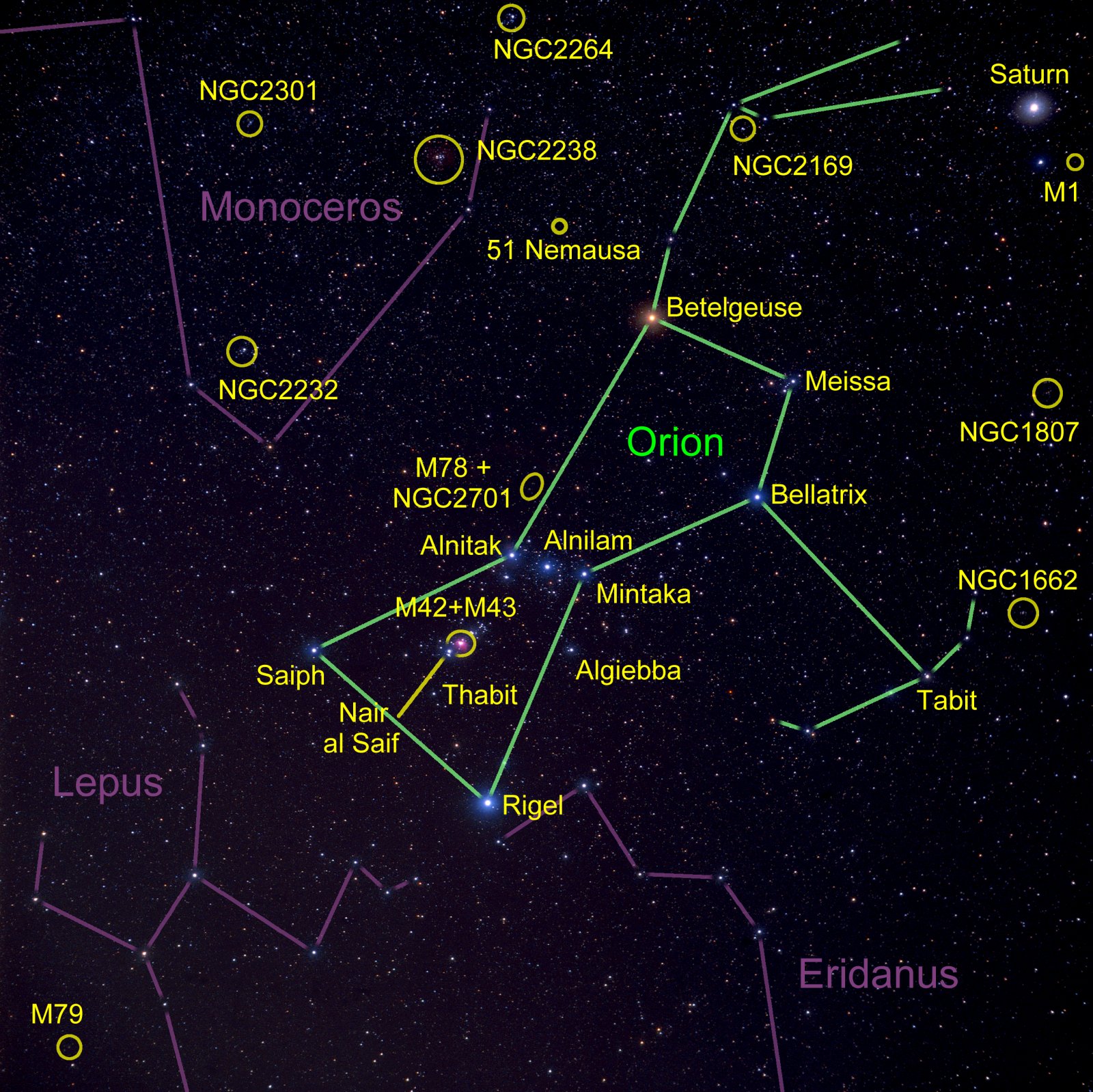 Science Daily: Mars
Science Daily: Mars
- Surprising insights about debris flows on Mars March 14, 2024
- Giant volcano discovered on Mars March 13, 2024
 Science Daily: Uranus
Science Daily: Uranus
- New images reveal what Neptune and Uranus really look like January 5, 2024
- Ringing in the holidays with ringed planet Uranus December 19, 2023
 Science Daily: Pluto
Science Daily: Pluto
- How Pluto got its heart April 15, 2024
- Evidence of geothermal activity within icy dwarf planets February 15, 2024
 Science Daily: Kuiper Belt
Science Daily: Kuiper Belt
- How Pluto got its heart April 15, 2024
- Evidence of geothermal activity within icy dwarf planets February 15, 2024
Orion: The Hunter
| Object: | Orion | ||||
| Location: | Narrowsburg, NY | ||||
| Observer: | Roland Roberts | ||||
| Time: | 2002-Dec-08 01:20 EST | ||||
| Camera: | Yashica 12, 80 mm f/3.5 lens | ||||
| Film: | Fuji Provia 400F | ||||
| Exposure: | 20 min @ f/3.5 w/ Tiffen Fog-1 Filter | ||||
| Processing: |
|
Orion’s popularity stems largely from the brightness of his stars and the easy-to-spot three stars of his belt. Orion is easily visible even from urban locations (I can attest to this as a resident of New York City).
Labeled on this picture are the following objects (links take you off-site):
- Constellations (4): Orion (the Hunter), Lepus (the Hare), Monoceros (the Unicorn), and Eridanus (the River). Only Orion is fully pictured, although most of Lepus is visible.
- Stars (12): Betelgeuse (alpha Orionis), Rigel (beta Orionis), Bellatrix (gamma Orionis), Mintaka (delta Orionis), Alnilam (epsilon Orionis), Alnitak (zeta Orionis), Na’ir al Saif (iota Orionis), Saiph (kappa Orionis), Heka or Meissa (lambda Orionis), Thabit (upsilon Orionis), Tabit (pi-3 Orionis), Algiebba (eta Orionis).
- Open Clusters: NGC 2301, NGC 2264, NGC 2238, NGC 2169, NGC 1662, NGC 1807.
- Globular Clusters: M79
- Nebula: M1, M42, M43, M78, NGC 2237.
Dolan’s web site lists Thabit as pi-3 Orionis and Tabit as upsilon Orionis (which is how they are labelled on the chart), but Gibson lists Tabit as a name sometimes given to pi or tau. Oh, and in case you are wondering about the “pi-3” designation, start at the top of Orion’s bow/shield and count. The topmost is pi-1, the middle one labelled Thabit is pi-3 and the bottom-most one is pi-5. I don’t know the history of how they got named that way.
I have found two references to the name Algiebba, one in an old e-mail list and on on a PDF chart at MIT. I’m not clear where I originally found the name, nor it’s origin.
The Jordanian Astronomical Society has a page on Arabic star names which lists multiple names for some of the stars in Orion.
The Rosette Nebula (NGC 2237-2239, 2246) is not quite visible in this shot. A close-up of the region where it sits shows just a hint of the red, annular nebula. This 20-minute exposure on Provia 400F was not quite enough. I’ve labeled the entire thing NGC 2238, but see the this reference on the SEDS web site which explains a little about the multiple NGC assignments.
Resources
Imagining Things?
Some of the items marked on the photo are very nearly invisible, especially after the image is downsampled so it fits on your screen. Am I making them up? Here are some enlargements.
Cropped Region around NGC2238
First is this image of the detail around NGC2238. The image has had its gamma adjusted to 1.5 compared to the main image. The nebulosity is there, but faint in the original. This adjustment makes it just a bit more obvious, though this won’t win any awards.
And yes, that tiny, nearly invisible dot in the center of the yellow circle labelled 51 Nemausa really is the asteroid and it really is on the film even if you still aren’t quite sure while squinting at your screen.

Cropped Region around M1
Here is a closeup of the M1 region. This is just cropped from the original which produced the main image above. The glow at the top is from Saturn. Right in the center of the marker circle is M1. I’ve never tried to find M1 from a dark site and my attempts from New York City have been fruitless. So this constitutes my first “viewing” of M1!

About the Pictures
I set out to get a picture of Orion on this particular night, but I had naturally expected to take several pictures. Alas, it was not to be. I arrived in Narrowsburg a little later than expected so it was already dark and I had to haul everything 100 meters up and down a hill to the riverbank through 8-inches of snow in the dark. Then I realized this was the first time I had used my CG-5 mount since I had given it a “tune-up.” Among the things I had tuned was the tension on the RA drive. It was too tight and the motors couldn’t turn it. So I had to take off the motors and adjust the worm tension in the dark, sub-freezing temperatures. I finally got it working and managed to get everything polar aligned. I strung 100 meters of extension cord to make a hair dryer available for frost removal/prevention. I was finally read to go. Into the house, prep the cameras, back out to mount them. The YashicaMAT-124 would not focus. After some poking (in the dark and cold), I determined the focusing mechanism was broken. Set up the remainder and finally go. Orion had already transited the meridian at this point and was getting closer and closer to the light dome thrown up by nearby Honesdale, PA. But, I got my 20- and 40-minute shots. I moved on to a 20-minute shot of Auriga. At this point, it was nearly 4 AM and I couldn’t keep my feet warm. I packed everything back in.
After developing everything, I discovered the two 35 mm cameras were set up incorrectly—I forgot to move the shutter to “B” and had left it on 1/1000 second. Somehow I botched the film advance on the last frame for the picture of Auriga and so I had nothing. But I did get Orion. So I guess you could say I accomplished my goal.
I will be trying again. I had loaded Kodak E200 into the YashicaMAT-124 (the one with the broken focusing mechanism), and the Fuji Provia 400F just didn’t have the kind of red response I needed for a 40-minute exposure. In the original, you can see a hint of Barnard’s Loop and the Rosette Nebula, but after the gradient removal process it is totally gone. I suspect a longer exposure might have had it, but that’s questionable with the sky glow.
Search
.Archives
- April 2024 (3)
- September 2022 (5)
- April 2022 (1)
- January 2022 (3)
- December 2021 (4)
- September 2021 (3)
- July 2021 (1)
- January 2021 (1)
- November 2020 (2)
- October 2020 (2)
- September 2020 (2)
- August 2020 (5)
- July 2020 (1)
- November 2019 (2)
- September 2019 (1)
- August 2019 (2)
- September 2017 (1)
- August 2017 (1)
- September 2015 (3)
- August 2015 (2)
- June 2015 (5)
- May 2015 (3)
- May 2013 (2)
- January 2013 (1)
- December 2012 (2)
- September 2012 (1)
- June 2012 (1)
- May 2012 (1)
- October 2011 (2)
- September 2011 (2)
- April 2011 (2)
- March 2011 (10)
- January 2011 (8)
- November 2010 (2)
- October 2010 (1)
- September 2010 (3)
- August 2010 (2)
- July 2010 (1)
- June 2010 (1)
- April 2010 (3)
- February 2010 (3)
- January 2010 (3)
- December 2009 (6)
- November 2009 (3)
- October 2009 (7)
- September 2009 (8)
- August 2009 (4)
- July 2009 (1)
- June 2009 (2)
- May 2009 (2)
- April 2009 (7)
- March 2009 (1)
- February 2009 (6)
- January 2009 (4)
- December 2008 (4)
- November 2008 (3)
- October 2008 (11)
- September 2008 (4)
- August 2008 (5)
- July 2008 (5)
- June 2008 (2)
- April 2008 (4)
- March 2008 (18)
- February 2008 (9)
- November 2007 (1)
- October 2007 (3)
- July 2007 (3)
- April 2007 (1)
- March 2007 (6)
- February 2007 (3)
- December 2006 (3)
- October 2006 (4)
- September 2006 (1)
- July 2006 (5)
- May 2006 (10)
- April 2006 (9)


